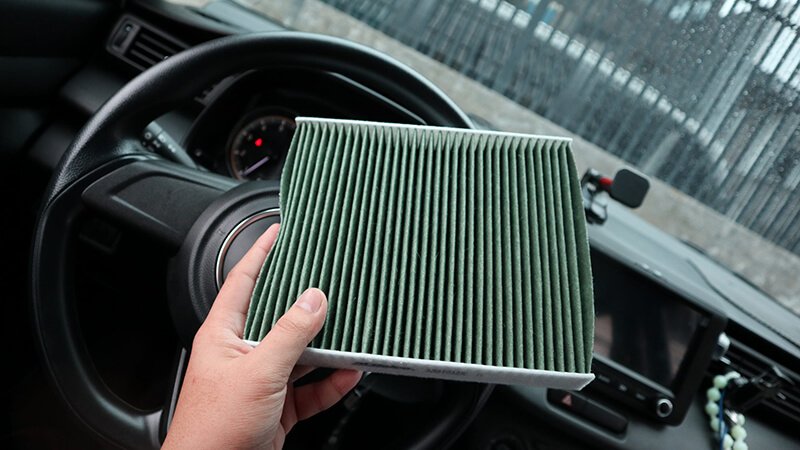A clogged air filter cuts power and wastes fuel. That pain pushes many drivers to try quick fixes.
Yes, some filters can be washed and reused, but only if the design supports cleaning. Paper filters should never be washed because water destroys their fibers and leaves your engine unprotected.
When I guide clients, I first help them spot which filter type they have. Then I show step-by-step care. Let me walk you through the key questions.

Can I wash and reuse a car air filter?
Bad airflow robs the engine of oxygen. The car feels lazy. Washing the filter looks like a fast win. But here is the catch: not every filter can handle water.
Only reusable filters—cotton, foam, or special synthetic layers—survive washing. Standard paper filters break apart, lose shape, and let dirt pass.
Why Material Choice Matters
I have seen fleets switch to washable filters1 and cut costs by 20 %. The move only worked because they chose the right material and followed the right wash cycle. When paper filters were cleaned by mistake, fine dust bypassed the media and scraped cylinder walls.
Filter Materials at a Glance
| Filter Type | Washable | Typical Lifespan* | Up-front Cost | Cost Per 100 km | Notes |
|---|---|---|---|---|---|
| Paper (cellulose) | No | 15 000–30 000 km | Low | Medium | Replace only |
| Oiled Cotton | Yes | 80 000–120 000 km | High | Low | Needs re-oil |
| Foam (polyurethane) | Yes | 50 000–80 000 km | Medium | Low | Good for off-road |
| Dry Synthetic | Partial | 30 000–60 000 km | Medium | Medium | Tap clean only |
*Real service life depends on dust level and driving style.
How to Decide in the Workshop
- Check the frame. If it has a thick rubber edge and stainless mesh, it is likely reusable.
- Look for a wash guide. Reusable filters come with cleaning instructions2.
- Ask your supplier. At Runex Auto we mark every carton with a big green “REUSABLE” label.
My own story: A distributor in Kenya once mixed stock and sold washable cotton filters to taxi drivers who treated them like paper. They never oiled them after wash. Within weeks mass airflow sensors failed. After training and clear labels, returns dropped to zero.

Can you put a wet air filter back in your car?
Time is tight, the filter looks clean, but it is still damp. You might think “it will dry while I drive.” Do not risk it.
Never reinstall a wet filter. Water disrupts airflow, feeds mold, and can enter the combustion chamber, causing costly damage.
The Real Cost of Moisture
Water does not compress. Even tiny droplets sucked into the cylinders can cause a hydraulic lock3. I saw this in a coastal courier fleet. Two vans bent connecting rods after drivers refitted wet filters during a rainstorm.
Moisture Trouble Map
| Problem | How It Starts | Visible Sign | Engine Risk Level |
|---|---|---|---|
| Hydro-lock | Water enters intake | Engine stops suddenly | Extreme |
| Mold growth | Damp fibers stay warm | Musty smell in cabin | Medium |
| Frame warp | Foam swells unevenly | Filter no longer seals | High |
| Sensor fault | Water hits hot wire | Check-engine light | Medium |
Drying Done Right
- Shake off water. Do not wring or twist.
- Air-dry in shade. Sunlight can crack rubber edges.
- Wait at least 12 h. In humid zones, extend to 24 h.
- Check weight. A dry cotton filter returns to its original light feel.
A personal note: I once used a heat gun to rush-dry a foam sample for a show demo. The foam shrank, the fit was loose, and the sample fell apart during testing. It cost me a key prospect. Lesson learned—patience beats speed.

Can you rinse and reuse air filters?
A quick rinse removes loose dust, yet deeper grime may hide between fibers. Proper cleaning is more than a splash of water.
You can rinse reusable filters, but you must also apply a suitable cleaner, flush from inside out, let the filter dry fully, and re-oil if needed. Skipping any step shortens filter life.
Step-by-Step Cleaning Guide
1. Pre-Clean Shake
Tap the filter gently to drop sand and insects. Never bang it on hard metal; that cracks seals.
2. Soak with Cleaner
Special low-foam agents loosen oil and soot. At Runex Auto we supply a citrus-based spray4. It is safe for rubber and your skin.
3. Rinse from Clean Side Out
Low-pressure water pushes dirt out the way it came in. High-pressure jets fold pleats and tear glue lines.
4. Air-Dry Thoroughly
Do not use compressed air—it drives fibers apart. Lay flat on a clean towel.
5. Re-Oil (for cotton media)
Oil traps dust. Use light even strokes. Over-oiling chokes flow and fouls sensors.
| Cleaning Step | Tool Needed | Typical Time | Common Mistake | Fix |
|---|---|---|---|---|
| Shake | Rubber mallet? No! | 1 min | Hitting on bench | Tap by hand |
| Soak | pH-neutral cleaner5 | 10 min | Household bleach | Use approved agent |
| Rinse | Garden hose | 2 min | Power washer | Keep pressure low |
| Dry | Open rack | 12–24 h | Oven or sun | Shade + air flow |
| Re-Oil | Light oil spray | 2 min | Oil puddles | Wipe extra off |
Real-World Payoff
A mining truck fleet in Chile followed this cycle and doubled filter life in dusty terrain. They cut yearly spend by 18 000 USD. Discipline won the savings.

What happens if you put air filter in backwards in car?
The filter fits either way, so does direction truly matter? Yes. It matters a lot.
Installing an air filter backward chokes airflow, distorts the sealing edge, and can let dirt pass straight into the intake. Expect power loss, poor mileage, and possible engine wear.
How Reversed Flow Hurts
Airflow Mechanics
Air filters are engineered with a “dirty” side that spreads flow across wide pleats and a “clean” side that funnels air smoothly. Flipping the filter forces air through the narrow exit first, raising resistance.
| Effect | Backward Filter | Correct Filter |
|---|---|---|
| Airflow (CFM)6 | ↓ up to 35 % | Baseline |
| Dust capture7 | ↓—dust bypasses | Optimal |
| Fuel trim | Rich mix | Balanced |
| Engine noise | Higher intake roar | Normal |
Support Grid Position
Many filters hold a plastic or metal grid on the clean side. Backwards, the grid faces dust and soon clogs. I saw this with a dealer who returned 300 filters as “defective.” The real defect was installation error. We added big red arrows and easy-read QR manuals on the box. Complaints vanished.
Quick Orientation Checks
- Look for arrow. It points toward the engine.
- Feel the pleats. Dirty side pleats are deeper.
- Check grid. Grid should face the engine side.
- Ask. When in doubt, phone the supplier.
One more tip: Some mechanics mark the box and the housing with matching lines. It takes seconds and prevents mistakes when service teams rotate.

Conclusion
Reusable filters8 save money only when you follow correct care: wash the right material, dry it fully, oil it if needed, and install it in the right direction. Never clean paper media, never fit a damp unit, and never flip orientation. Simple steps guard engines, cut costs, and keep customers happy—lessons I’ve learned the hard way and now share with every Runex Auto partner.
-
Explore the advantages of washable filters to understand how they can save costs and improve vehicle performance. ↩
-
Discover the significance of following cleaning instructions to ensure the longevity and effectiveness of reusable filters. ↩
-
Understanding hydraulic lock is crucial for preventing engine damage. Explore this link to learn more about its causes and prevention methods. ↩
-
Explore the advantages of citrus-based cleaners, which are effective, safe for various materials, and environmentally friendly. ↩
-
Learn why pH-neutral cleaners are essential for maintaining filter integrity and preventing damage during cleaning. ↩
-
Understanding airflow's effect on engine performance can help optimize vehicle efficiency and longevity. Explore this link for detailed insights. ↩
-
Learn how effective dust capture can enhance air filter performance and protect your engine. This resource provides valuable information. ↩
-
Know high-quality auto air filter, clicking this link to get your best type for your car from Runex Auto. ↩













